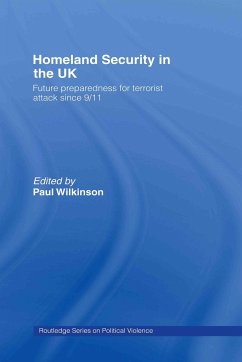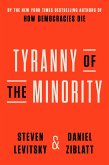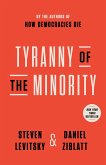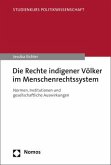Paul Wilkinson (ed.)Future Preparedness for Terrorist Attack Since 9/11
Homeland Security in the UK
Future Preparedness for Terrorist Attack Since 9/11
Herausgeber: Wilkinson, Paul
Paul Wilkinson (ed.)Future Preparedness for Terrorist Attack Since 9/11
Homeland Security in the UK
Future Preparedness for Terrorist Attack Since 9/11
Herausgeber: Wilkinson, Paul
- Gebundenes Buch
- Merkliste
- Auf die Merkliste
- Bewerten Bewerten
- Teilen
- Produkt teilen
- Produkterinnerung
- Produkterinnerung
This book is a detailed examination of whether domestic security measures are striking an appropriate balance between homeland security and civil liberties in the post-9/11 era.
Andere Kunden interessierten sich auch für
![Homeland Security in the UK Homeland Security in the UK]() Paul Wilkinson (ed.)Homeland Security in the UK44,99 €
Paul Wilkinson (ed.)Homeland Security in the UK44,99 €![The Architecture of Modern Empire The Architecture of Modern Empire]() Arundhati RoyThe Architecture of Modern Empire58,99 €
Arundhati RoyThe Architecture of Modern Empire58,99 €![The Architecture of Modern Empire The Architecture of Modern Empire]() Arundhati RoyThe Architecture of Modern Empire8,99 €
Arundhati RoyThe Architecture of Modern Empire8,99 €![Tyranny of the Minority Tyranny of the Minority]() Steven LevitskyTyranny of the Minority13,99 €
Steven LevitskyTyranny of the Minority13,99 €![Tyranny of the Minority Tyranny of the Minority]() Steven LevitskyTyranny of the Minority13,99 €
Steven LevitskyTyranny of the Minority13,99 €![Tyranny of the Minority Tyranny of the Minority]() Steven LevitskyTyranny of the Minority9,99 €
Steven LevitskyTyranny of the Minority9,99 €![Die Rechte indigener Völker im Menschenrechtssystem Die Rechte indigener Völker im Menschenrechtssystem]() Jessika EichlerDie Rechte indigener Völker im Menschenrechtssystem24,00 €
Jessika EichlerDie Rechte indigener Völker im Menschenrechtssystem24,00 €-
-
-
This book is a detailed examination of whether domestic security measures are striking an appropriate balance between homeland security and civil liberties in the post-9/11 era.
Hinweis: Dieser Artikel kann nur an eine deutsche Lieferadresse ausgeliefert werden.
Hinweis: Dieser Artikel kann nur an eine deutsche Lieferadresse ausgeliefert werden.
Produktdetails
- Produktdetails
- Verlag: Taylor & Francis
- Seitenzahl: 432
- Erscheinungstermin: 14. Juni 2007
- Englisch
- Abmessung: 234mm x 166mm x 29mm
- Gewicht: 785g
- ISBN-13: 9780415383745
- ISBN-10: 0415383749
- Artikelnr.: 22516703
- Herstellerkennzeichnung
- Libri GmbH
- Europaallee 1
- 36244 Bad Hersfeld
- gpsr@libri.de
- Verlag: Taylor & Francis
- Seitenzahl: 432
- Erscheinungstermin: 14. Juni 2007
- Englisch
- Abmessung: 234mm x 166mm x 29mm
- Gewicht: 785g
- ISBN-13: 9780415383745
- ISBN-10: 0415383749
- Artikelnr.: 22516703
- Herstellerkennzeichnung
- Libri GmbH
- Europaallee 1
- 36244 Bad Hersfeld
- gpsr@libri.de
Paul Wilkinson
Part 1: Introduction 1. Introduction Paul Wilkinson Part 2: Threat
Assessment 2. The Threat from the Al-Qaeda Network Paul Wilkinson 3.
International Terrorism and the UK: Assessing the Threat Tamara Makarenko
4. The Chemical, Biological, Radiological and Nuclear Weapons Threat Jez
Littlewood and John Simpson 5. The Domestic Threat: The Cases of Northern
Ireland and Animal Rights Extremism Anthony Richards Part 3: UK Efforts to
Enhance Preparedness since 9/11 6. National Governance Structures to Manage
the Response to Terrorist Threats and Attacks: A Cross-National Comparative
Analysis with Special Reference to the UK 'Lead Department' Response
Structure and UK Counter-Terrorism Strategy Frank Gregory 7. Reducing the
Chemical, Biological, Radiological and Nuclear Weapons Threat: The Role of
Counter-Proliferation, Arms Control and Disarmament John Simpson and Jez
Littlewood 8. The UK and the Threat of Nuclear Terrorism: A Case Study of
Organisational Responses John Simpson 9. An Assessment of the Contribution
of Intelligence-Led Counter-Terrorism to UK Homeland Security Post 9/11
within the 'Contest' Strategy Frank Gregory 10. Police and
Counter-Terrorism in the UK: A Study of 'One of the Highest and Most
Challenging Priorities for Police Forces Nationally' Frank Gregory 11.
Immigration and Asylum Issues Tamara Makarenko 12. Enhancing UK Aviation
Security Post 9/11 Paul Wilkinson 13. Port Security in the UK: The Spectre
of Maritime Terrorism Peter Lehr 14. Terrorism and Public Information
Anthony Richards 15. Cyber-Security and the Critical National
Infrastructure Darryl Howlett 16. Private Sector Roles in Counter-Terrorism
Frank Gregory Part 4: Civil Contingencies and Emergency Response 17. UK
Draft Civil Contingencies Bill 2003 and its Subsequent Act: Building Block
for Homeland Security? Frank Gregory 18. The Emergency Response: Progress
and Problems Anthony Richards Part 5: International Dimensions and Main
Conclusions of Authors 19. International Dimensions of Homeland Security
Paul Wilkinson 20. Main Conclusions of the Authors Project Team
Assessment 2. The Threat from the Al-Qaeda Network Paul Wilkinson 3.
International Terrorism and the UK: Assessing the Threat Tamara Makarenko
4. The Chemical, Biological, Radiological and Nuclear Weapons Threat Jez
Littlewood and John Simpson 5. The Domestic Threat: The Cases of Northern
Ireland and Animal Rights Extremism Anthony Richards Part 3: UK Efforts to
Enhance Preparedness since 9/11 6. National Governance Structures to Manage
the Response to Terrorist Threats and Attacks: A Cross-National Comparative
Analysis with Special Reference to the UK 'Lead Department' Response
Structure and UK Counter-Terrorism Strategy Frank Gregory 7. Reducing the
Chemical, Biological, Radiological and Nuclear Weapons Threat: The Role of
Counter-Proliferation, Arms Control and Disarmament John Simpson and Jez
Littlewood 8. The UK and the Threat of Nuclear Terrorism: A Case Study of
Organisational Responses John Simpson 9. An Assessment of the Contribution
of Intelligence-Led Counter-Terrorism to UK Homeland Security Post 9/11
within the 'Contest' Strategy Frank Gregory 10. Police and
Counter-Terrorism in the UK: A Study of 'One of the Highest and Most
Challenging Priorities for Police Forces Nationally' Frank Gregory 11.
Immigration and Asylum Issues Tamara Makarenko 12. Enhancing UK Aviation
Security Post 9/11 Paul Wilkinson 13. Port Security in the UK: The Spectre
of Maritime Terrorism Peter Lehr 14. Terrorism and Public Information
Anthony Richards 15. Cyber-Security and the Critical National
Infrastructure Darryl Howlett 16. Private Sector Roles in Counter-Terrorism
Frank Gregory Part 4: Civil Contingencies and Emergency Response 17. UK
Draft Civil Contingencies Bill 2003 and its Subsequent Act: Building Block
for Homeland Security? Frank Gregory 18. The Emergency Response: Progress
and Problems Anthony Richards Part 5: International Dimensions and Main
Conclusions of Authors 19. International Dimensions of Homeland Security
Paul Wilkinson 20. Main Conclusions of the Authors Project Team
Part 1: Introduction 1. Introduction Paul Wilkinson Part 2: Threat
Assessment 2. The Threat from the Al-Qaeda Network Paul Wilkinson 3.
International Terrorism and the UK: Assessing the Threat Tamara Makarenko
4. The Chemical, Biological, Radiological and Nuclear Weapons Threat Jez
Littlewood and John Simpson 5. The Domestic Threat: The Cases of Northern
Ireland and Animal Rights Extremism Anthony Richards Part 3: UK Efforts to
Enhance Preparedness since 9/11 6. National Governance Structures to Manage
the Response to Terrorist Threats and Attacks: A Cross-National Comparative
Analysis with Special Reference to the UK 'Lead Department' Response
Structure and UK Counter-Terrorism Strategy Frank Gregory 7. Reducing the
Chemical, Biological, Radiological and Nuclear Weapons Threat: The Role of
Counter-Proliferation, Arms Control and Disarmament John Simpson and Jez
Littlewood 8. The UK and the Threat of Nuclear Terrorism: A Case Study of
Organisational Responses John Simpson 9. An Assessment of the Contribution
of Intelligence-Led Counter-Terrorism to UK Homeland Security Post 9/11
within the 'Contest' Strategy Frank Gregory 10. Police and
Counter-Terrorism in the UK: A Study of 'One of the Highest and Most
Challenging Priorities for Police Forces Nationally' Frank Gregory 11.
Immigration and Asylum Issues Tamara Makarenko 12. Enhancing UK Aviation
Security Post 9/11 Paul Wilkinson 13. Port Security in the UK: The Spectre
of Maritime Terrorism Peter Lehr 14. Terrorism and Public Information
Anthony Richards 15. Cyber-Security and the Critical National
Infrastructure Darryl Howlett 16. Private Sector Roles in Counter-Terrorism
Frank Gregory Part 4: Civil Contingencies and Emergency Response 17. UK
Draft Civil Contingencies Bill 2003 and its Subsequent Act: Building Block
for Homeland Security? Frank Gregory 18. The Emergency Response: Progress
and Problems Anthony Richards Part 5: International Dimensions and Main
Conclusions of Authors 19. International Dimensions of Homeland Security
Paul Wilkinson 20. Main Conclusions of the Authors Project Team
Assessment 2. The Threat from the Al-Qaeda Network Paul Wilkinson 3.
International Terrorism and the UK: Assessing the Threat Tamara Makarenko
4. The Chemical, Biological, Radiological and Nuclear Weapons Threat Jez
Littlewood and John Simpson 5. The Domestic Threat: The Cases of Northern
Ireland and Animal Rights Extremism Anthony Richards Part 3: UK Efforts to
Enhance Preparedness since 9/11 6. National Governance Structures to Manage
the Response to Terrorist Threats and Attacks: A Cross-National Comparative
Analysis with Special Reference to the UK 'Lead Department' Response
Structure and UK Counter-Terrorism Strategy Frank Gregory 7. Reducing the
Chemical, Biological, Radiological and Nuclear Weapons Threat: The Role of
Counter-Proliferation, Arms Control and Disarmament John Simpson and Jez
Littlewood 8. The UK and the Threat of Nuclear Terrorism: A Case Study of
Organisational Responses John Simpson 9. An Assessment of the Contribution
of Intelligence-Led Counter-Terrorism to UK Homeland Security Post 9/11
within the 'Contest' Strategy Frank Gregory 10. Police and
Counter-Terrorism in the UK: A Study of 'One of the Highest and Most
Challenging Priorities for Police Forces Nationally' Frank Gregory 11.
Immigration and Asylum Issues Tamara Makarenko 12. Enhancing UK Aviation
Security Post 9/11 Paul Wilkinson 13. Port Security in the UK: The Spectre
of Maritime Terrorism Peter Lehr 14. Terrorism and Public Information
Anthony Richards 15. Cyber-Security and the Critical National
Infrastructure Darryl Howlett 16. Private Sector Roles in Counter-Terrorism
Frank Gregory Part 4: Civil Contingencies and Emergency Response 17. UK
Draft Civil Contingencies Bill 2003 and its Subsequent Act: Building Block
for Homeland Security? Frank Gregory 18. The Emergency Response: Progress
and Problems Anthony Richards Part 5: International Dimensions and Main
Conclusions of Authors 19. International Dimensions of Homeland Security
Paul Wilkinson 20. Main Conclusions of the Authors Project Team









